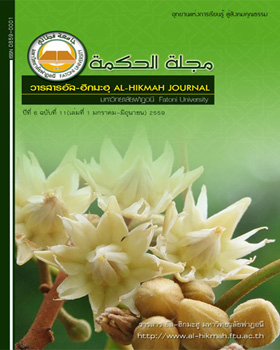Effects of Inquiry-Based Approach and Polya’s Problem Solving on Physics Achievement and Problem Solving Ability of Grade 12 Students
Keywords:
Polya’s Problem Solving, Physics Achievement and Problem Solving AbilityAbstract
This research aimed to study the Effects of Inquiry-Based Approach and Polya’s Problem Solving on Physics Achievement and Problem Solving Ability of Grade 12 Students. The sample group of this research was 30 students in Grade 12/1 classroom of Grade 12 Students at Muslimpattanasart School, Yaring District, Pattani Province during the second semester of the 2014 academic year, received by purposive sampling. They were instructed for 15 hours. The research instruments consisted of lesson plans, achievement test Physics, problem - solving ability test, Satisfaction Questionnaires, the observation of students form, field note and an interview and one group pretest - posttest design. The data were analyzed by mean, standard deviation and t - test for dependent groups.
The result were shown as follows: The students achievement was significantly higher on the posttest than pretest (p < .01). The students achievement level average on the posttest is Satisfactory level. The students problem-solving ability was significantly higher on the posttest than pretest (p<.01). and The students satisfaction with Inquiry-Based Approach and Polya’s Problem Solving overall is at high level.
References
ณัฐพร โพธิ์เอี่ยม. 2550. การพัฒนาผลการเรียนรู้เรื่อง โจทย์ปัญหาของนักเรียนชั้นประถมศึกษา ปีที่ 4 ที่จัดการเรียนรู้แบบกลุ่มเป็นรายบุคล (TAI) ร่วมกับกระบวนการแก้ปัญหาของโพลยา. วิทยานิพนธ์การศึกษามหาบัณฑิต
สาขาวิชาหลักสูตรและการนิเทศ มหาวิทยาลัยศิลปากร.
ทรรศนัย โกวิทยากร. 2546. การศึกษาความสามารถ ในการแก้ปัญหาเชิงตรรกของนักเรียนที่มี ความสามารถพิเศษชั้นประถมศึกษาปีที่ 5 จากการใช้รูปแบบการสอนของโพลยา. ปริญญาการศึกษามหาบัณฑิต. กรุงเทพฯ: มหาวิทยาลัยศรีนครินทรวิโรฒ ประสานมิตร.
บุญชม ศรีสะอาด. 2545. การวิจัยเบื้องต้น. พิมพ์ครั้งที่ 7. กรุงเทพมหานคร: สุวีริยาสาส์น.
พนารัตน์ วัดไชยแสง. 2544. ผลสัมฤทธิ์ทางการเรียนวิชาวิทยาศาสตร์และความสามารถในการ แก้ โจทย์ปัญหาของนักเรียนชั้นมัธยมศึกษาปีที่ 3 ที่ได้รับการสอนแบบสืบเสาะหาความรู้และ แก้ปัญหาโจทย์ตามเทคนิคของโพลยา. วิทยานิพนธ์ศึกษาศาสตรมหาบัณฑิต สาขาวิชาวิทยาศาสตร์ศึกษา มหาวิทยาลัยเชียงใหม่.
พิมพ์สรณ์ ตุกเตียน. 2552. ผลการใช้วิธีสอนแก้โจทย์ปัญหาของโพลยาร่วมกับเทคนิคการจัดกลุ่ม แบบรายบุคคล (TAI) ต่อความสามารถในการ แก้โจทย์ปัญหาทางคณิตศาสตร์ของนักเรียน ชั้นประถมศึกษาปีที่3. วิทยานิพนธ์ศึกษาศาสตรมหาบัณฑิต สาขาวิชาหลักสูตรและการสอน มหาวิทยาลัยทักษิณ.
มาลัย เกื้อกิจ. 2552. การสร้างแบบฝึกทักษะตาม กระบวนการแก้ปัญหาของโพลยาเพื่อพัฒนา ผลสัมฤทธิ์ทางการเรียนคณิตศาสตร์ เรื่อง โจทย์ปัญหาระคนของนักเรียนชั้นประถมศึกษาปีที่3. วิทยานิพนธ์ การศึกษามหาบัณฑิต สาขาวิชาวิจัยและประเมินผลการศึกษา ภาควิชาการศึกษา มหาวิทยาลัยเกษตรศาสตร์.
วิจารณ์ พานิช. 2555. วิถีสร้างการเรียนรู้เพื่อศิษย์ ในศตวรรษที่ 21. กรุงเทพมหานคร: มูลนิธิสดศรี-สฤษดิ์วงศ์.
วิชัย วงษ์ใหญ่. 2542. พลังการเรียนรู้ในกระบวน ทัศน์ใหม่. กรุงเทพมหานคร: อำนวยการพิมพ์.
สำนักงานปลัดกระทรวงศึกษาธิการ. 2544. ปฏิรูปการ ศึกษา ตามพระราชบัญญัติการศึกษาแห่งชาติ พ.ศ. 2542. กรุงเทพฯ : โรงพิมพ์คุรุสภา.
อาภรณ์ ใจเที่ยง. 2546. หลักการสอน (ฉบับปรับปรุง). พิมพ์ครั้งที่ 3. กรุงเทพมหานคร: โอเดียนสโตร์.
G. Polya. 2004. How to solve: A New Aspect of Mathematical Method. New York: Henry Houbleday & Company.



